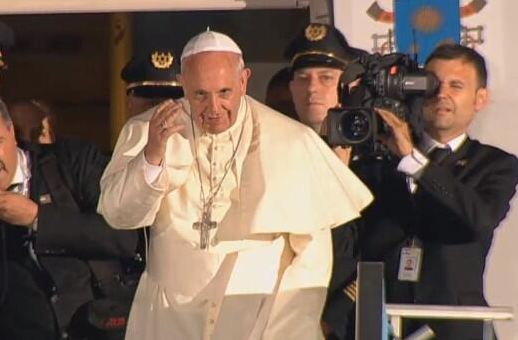
VATICAN CITY — Pope Francis’ five-day visit to South Korea will be the first time in a quarter-century that a pope has been on the divided Korean peninsula. Francis plans to bring a message of peace and reconciliations to Koreans on both sides of the 38th parallel, while encouraging Catholics in the region to spread their faith. Here are five things to know about the trip, which gets underway with Francis’ departure Wednesday from Rome and arrival in Seoul on Thursday morning.
—
CHINA FLY-BY
Vatican protocol calls for the pope to send greetings to the heads of state of the countries he flies over when traveling. Usually, these telegrams aren’t worth mentioning, except that Pope Francis will be flying through Chinese airspace en route to Seoul. China and the Holy See haven’t had diplomatic relations since 1951, when the officially atheistic Communist Party took power and set up its own church outside the pope’s authority. As a result, the papal fly-by will offer Francis a rare chance to speak directly to the Chinese leadership. When St. John Paul II last visited South Korea in 1989, tensions were so high that China refused to let his plane fly through its airspace. Instead, the Alitalia charter flew via Russian airspace, providing John Paul with a first-ever opportunity to send radio greetings to Soviet President Mikhail Gorbachev. (He said he hoped to visit Moscow soon.) Francis has already exchanged informal (and private) letters with Chinese President Xi Jinping, so the papal telegram should at the very least offer a first public view of Vatican efforts under Francis to engage the Beijing leadership.
—
KOREA’S MARTYRS
One of the highlights of Francis’ trip is the Aug. 16 beatification of 124 Korean martyrs, killed for their faith by the anti-Western rulers of the Joseon Dynasty in the 18th and 19th centuries. Unlike most countries where missionary priests brought Catholicism and spread it, South Korea’s church is uniquely homegrown: Members of Korea’s noble classes discovered the faith in the 18th century reading books by the Jesuit missionary Matteo Ricci that they brought back from China. Their interest spread, until finally the first Korean was baptized in Beijing in 1784. Historians say early believers were struck by the idea of a religion that preached universal equality in divine eyes at a time when the nobility’s discriminatory hierarchical system brutally exploited ordinary people. Despite its local roots, Korean Catholics weren’t immune from persecutions waged against Christians across Asia and an estimated 10,000 Korean Catholics were killed by the Joseon Dynasty, which tried to shut the Korean Peninsula off from Western influence. Those being beatified were the founders of the Korean church. John Paul II canonized another 103 of these martyrs during his 1984 visit.
—
AND KOREAN CATHOLICS TODAY?
Despite a history of persecution, South Korea’s Catholic Church has hung in there, and then some. A half-century ago, Catholics represented about 1 percent of the population; today they represent 10 percent of the population of 50 million, and Vatican statistics show that more than 100,000 people are baptized every year. Once a country that welcomed missionaries to help spread the faith, South Korea now sends its own priests and nuns abroad to evangelize other countries: Nearly 1,000 are currently on mission. Francis is expected to encourage this missionary spirit among Koreans and Asian Catholics: The main reason for his trip is to participate in the Asian version of World Youth Day, the giant Catholic youth fest that the church uses to inspire a new generation of Catholics.
—
WHAT ABOUT NORTH KOREAN CATHOLICS?
Some historians say there were as many as 300,000 North Korean Christians in 1953, at the end of the Korean War. “Now they’re practically all dead, many killed by the so-called death marches, from poverty or violent successive persecutions,” historian Vincenzo Faccioli Pintozzi wrote in “Young People and Martyrs in Asia: Pope Francis’ Mission in Korea,” a new book about the Korean church published in Italy. Currently, there are no Vatican-recognized church structures or priests operating in North Korea. The Seoul archdiocese invited a delegation of Christians from North Korea to participate in Francis’ final Aug. 18 Mass in Seoul’s cathedral. But the Vatican said last week that authorities in the North had declined the invitation. Francis is, however, expected to issue a message of peace and reconciliation for all Koreans during the Mass.
—
FRANCIS’ OTHER NODS
While martyrs, missionaries and peace on the Korean peninsula are the main themes of Francis’ trip, he’ll have a few occasions to issue other messages. During his April 15 Mass, Francis is expected to console survivors of South Korea’s April ferry sinking, which left more than 300 people, most of them students, dead or missing. A day later, he is to pray at a garden for aborted fetuses and meet with a pro-life activist. Francis is also expected to briefly greet a small delegation of Korean women used as sex slaves by Japan’s military during World War II. These former “comfort women” are expected at his final Aug. 18 Mass of peace and reconciliation in Seoul’s main cathedral.